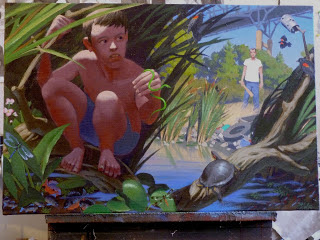Mary and Martha by Bernardino Luini (Wikimedia Commons)
Mary and Martha of Bethany were two of Jesus’ closest friends. The Bible calls them “sisters” who lived together, but reading the Bible with queer eyes raises another possibility. Maybe Mary and Martha were a lesbian couple. Their feast day is today (July 29).
Mary and Martha formed a nontraditional family at a time when there was huge pressure for heterosexual marriage.
As Nancy Wilson, moderator of Metropolitan Community Churches, wrote in the brochure “Our Story Too: Reading the Bible with ‘New’ Eyes”:
“Jesus loved Lazarus, Mary and Martha. What drew Jesus to this very non-traditional family group of a bachelor brother living with two spinster sisters? Two barren women and a eunuch are Jesus’ adult family of choice. Are we to assume they were all celibate heterosexuals? What if Mary and Martha were not sisters but called each other ‘sister’ as did most lesbian couples throughout recorded history?”
Wilson expands on this theory in her book Outing the Bible: Queer Folks, God, Jesus, and the Christian Scriptures
Biblical patriarchs have also hidden their marriages by claiming their wives were their sisters. In the book of Genesis, Abraham claimed his wife Sarah was his sister on two different occasions (Genesis 12:10-20; 20:1-18) and once Isaac passed off his wife Rebekah as his sister (Genesis 26:1-16).
Mary and Martha are best known for the conflict they had when they hosted Jesus and his disciples. Mary sat at Jesus’ feet to listen, but Martha wanted her to help her serve. Jesus’ famous answer: “Martha, Martha, you are worried and upset about many things, but only one thing is needed. Mary has chosen what is better, and it will not be taken away from her.” (Luke 10:41-42).
In another major Bible story, Jesus talks with Mary and Martha in turn before raising their brother Lazarus from the dead. During the conversation, Martha speaks what is considered the first profession of faith in Jesus: “I believe that you are the Christ, the Son of God, who was to come into the world” (John 11:27).
Like with most Biblical figures, the truth about Mary and Martha is a mystery. The gospels references are brief and sometimes contradictory. As a result, Mary of Bethany is identified as Mary Magdalene in the Roman Catholic church, while in Protestant and Eastern Orthodox traditions they are considered separate persons.
The Orthodox Church also includes Mary and Martha among the “myrrh bearing women” who were faithfully present at his crucifixion and brought myrrh to his tomb, where they became the first to witness his resurrection. Christian feminists also honor the couple and say that they probably were leaders of a “house church.”
Artists provide some beautiful paintings of the “sisters,” including the one above by Italian Renaissance artist Bernardino Luini (1480 -1532). Magic realist painter Eileen Kennedy has done a new painting of them as contemporary women. Kennedy’s “In the House of Martha and Mary” is on view at the Episcopal Cafe Art Blog. Martha stands angrily with vacuum cleaner in hand as her sister listens to Jesus.
_________
This post is part of the GLBT Saints series at the Jesus in Love Blog. Saints and holy people of special interest to gay, lesbian, bisexual and transgender (GLBT) people and our allies are covered on appropriate dates throughout the year.
__________
Icons of Martha and Mary of Bethany and many others are available on cards, plaques, T-shirts, mugs, candles, mugs, and more at TrinityStores.com
Outing the Bible: Queer Folks, God, Jesus, and the Christian Scriptures












.jpg)



















